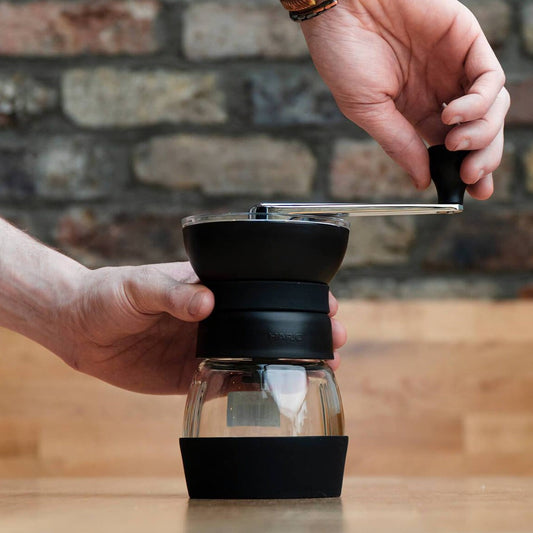Coffee is more than just a beverage—it’s a tradition, a social experience, and a deeply ingrained part of cultures across the globe.
From Ethiopia's intricate ceremonies to Italy's bustling espresso bars, each country has a unique way of preparing, serving, and enjoying coffee. These traditions reflect not just regional preferences but also centuries-old customs that bring people together.
Join us on a journey through some of the world’s most fascinating coffee rituals and discover how different cultures celebrate this beloved drink.
Ethiopian coffee ceremony: the birthplace of coffee
Ethiopia, often considered the birthplace of coffee, has one of the most elaborate and respected coffee traditions.
The Ethiopian coffee ceremony, or "Buna" as it's also known, is an integral part of daily life, symbolising hospitality, respect, and community.
The ritual and process
The preparation of Ethiopian coffee is meticulously carried out, starting with green coffee beans roasted over an open flame on a flat pan.
The aroma fills the room, signalling the beginning of the ceremony. The freshly roasted beans are then ground by hand using a wooden mortar and pestle before being brewed in a clay pot called a jebena.
The coffee is served in small, handleless cups and enjoyed over multiple rounds, reflecting the deepening of relationships and conversations among participants.
The ceremony includes three distinct rounds, each carrying its significance:
- Abol yields the boldest and most aromatic cup, highlighting the full intensity of the freshly roasted beans.
- The second round, Tona, is gentler, as the same grounds are reused, resulting in a smoother, more delicate flavour.
-
The final stage, Bereka, offers the lightest brew, marking the conclusion of the gathering while reinforcing the sense of connection among participants.
What makes it special?
The gradual progression of the rounds mirrors the deepening of conversations, while sharing stories, fostering unity and warmth throughout the ritual.
Burning frankincense is a common practice, creating a fragrant atmosphere and cleansing the space.
This slow, immersive process that takes time and attention is deeply tied to Ethiopian culture, ensuring that coffee is more than a drink—it is an experience rooted in tradition.

Italian espresso culture: quick, strong, and essential
Coffee first arrived in Italy in the late 16th century, making its way through Mediterranean trade routes.
Introduced to Venice around 1570, it quickly gained popularity, leading to the rise of Venetian coffeehouses, which became centres for intellectual and political debates during the Enlightenment era. These establishments became meeting places for philosophers, writers, and revolutionaries, fostering debates that influenced Italian society and governance.
By the 19th century, Italy had fully embraced coffee culture, and the invention of the espresso machine in 1884 by Angelo Moriondo revolutionised coffee preparation making espresso the defining drink of Italy.
Even today, coffee bars remain social hubs, where locals gather for daily rituals. Some of the oldest coffeehouses, such as Caffè Florian in Venice (established in 1720), continue to serve as historical landmarks, preserving Italy’s rich coffee heritage.
Espresso: the heart of Italian coffee culture
The espresso is at the heart of Italian coffee culture, enjoyed throughout the day as a quick but meaningful pause, a moment to connect with friends, where locals exchange greetings, discuss the latest news, or simply enjoy a brief moment of calm before returning to work.
Espresso is brewed under high pressure, producing a rich, intense shot topped with golden crema, perfect for a boost in energy. It’s rarely consumed while seated; instead, patrons order their coffee at the bar, take a few quick sips, and continue with their day.
Want to learn more about Espresso Culture? Read our blog!
Coffee customs in Italy
Cappuccino is a breakfast drink—ordering one after 11 AM is considered unusual and may raise eyebrows.
No takeaways—Espresso is traditionally enjoyed at the café bar, not on the go.
Espresso is always small and strong—no large, diluted versions. Instead, the focus is on a bold, concentrated shot.
Sugar or no sugar? Many Italians drink espresso black, embracing its bold flavour.
The beauty of Italian coffee culture lies in its simplicity—no extras, no distractions, just pure coffee enjoyment.
Turkish coffee tradition: strong, unfiltered, and full of history
Turkish coffee is so deeply rooted in tradition that it was inscribed on UNESCO’s Intangible Cultural Heritage List in 2013, recognising its importance in Turkish society.
Dating back to the Ottoman Empire, Turkish coffee is an ancient brewing method where coffee is boiled rather than steeped or filtered, creating a thick, velvety texture that distinguishes it from most Western styles.
Additionally, Turkish coffee is often flavoured with cardamom or mastic, adding aromatic depth to the experience.
The brewing method
Prepared in a small copper pot called a cezve, finely ground coffee is slowly simmered over low heat, producing a deep, intense flavour.
Sugar is often added directly during the brewing process rather than after, allowing it to dissolve fully into the rich coffee mixture.
Often served with a piece of Turkish delight, the coffee is poured without filtering. Once brewed, the coffee is poured into small, ornate cups, where it is left to settle, with the grounds resting at the bottom.
A tradition woven into daily life
Turkish coffee plays an essential role in social gatherings, friendships, and even marriage traditions. It is customary for a bride-to-be to prepare coffee for her future in-laws during an engagement ceremony. The way she brews the coffee is seen as a sign of her patience and hospitality—sometimes, she playfully adds salt instead of sugar to test how her fiancé reacts!
One of the most beloved traditions associated with Turkish coffee is tasseography—the practice of reading fortunes from coffee grounds. After finishing the coffee, the drinker flips their cup upside down onto the saucer, allowing the grounds to settle into unique patterns. A skilled fortune teller then interprets the symbols, offering insights into love, success, and upcoming events.
Drinking Turkish coffee is a ritual that encourages conversation and connection, making it a moment of reflection and connection rather than mere refreshment.
What makes Turkish coffee unique?
Boiling method creates a rich, thick texture with an intense aroma.
No filtration—grounds settle at the bottom, making the last sip bold.
These grounds are sometimes used for fortune-telling, with locals interpreting patterns to predict the future.
Drinking Turkish coffee is about more than just the taste—it’s about connection, storytelling, and centuries-old rituals.

Every country has its own coffee traditions, shaped by history, culture, and social practices. Whether it’s the slow and thoughtful Ethiopian coffee ceremony, the bold and fast-paced Italian espresso culture, or the rich and communal Turkish coffee ritual, coffee serves as a universal language of connection.
Exploring different coffee customs allows us to appreciate the diversity of this beloved drink, inspiring new ways to enjoy coffee in our own routines.
Which coffee tradition speaks to you?
Perhaps it’s time to experiment with a new brewing method or adopt a ritual from another culture!
In the next blog, we will cover other coffee cultures around the world. Stay tuned!






